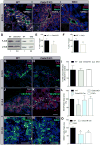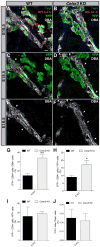Planar cell polarity controls pancreatic beta cell differentiation and glucose homeostasis
- PMID: 23177622
- PMCID: PMC3606931
- DOI: 10.1016/j.celrep.2012.10.016
Planar cell polarity controls pancreatic beta cell differentiation and glucose homeostasis
Abstract
Planar cell polarity (PCP) refers to the collective orientation of cells within the epithelial plane. We show that progenitor cells forming the ducts of the embryonic pancreas express PCP proteins and exhibit an active PCP pathway. Planar polarity proteins are acquired at embryonic day 11.5 synchronously to apicobasal polarization of pancreas progenitors. Loss of function of the two PCP core components Celsr2 and Celsr3 shows that they control the differentiation of endocrine cells from polarized progenitors, with a prevalent effect on insulin-producing beta cells. This results in a decreased glucose clearance. Loss of Celsr2 and 3 leads to a reduction of Jun phosphorylation in progenitors, which, in turn, reduces beta cell differentiation from endocrine progenitors. These results highlight the importance of the PCP pathway in cell differentiation in vertebrates. In addition, they reveal that tridimensional organization and collective communication of cells are needed in the pancreatic epithelium in order to generate appropriate numbers of endocrine cells.
Copyright © 2012 The Authors. Published by Elsevier Inc. All rights reserved.
Figures







Similar articles
-
Threshold-Dependent Cooperativity of Pdx1 and Oc1 in Pancreatic Progenitors Establishes Competency for Endocrine Differentiation and β-Cell Function.Cell Rep. 2016 Jun 21;15(12):2637-2650. doi: 10.1016/j.celrep.2016.05.040. Epub 2016 Jun 9. Cell Rep. 2016. PMID: 27292642 Free PMC article.
-
Lack of cadherins Celsr2 and Celsr3 impairs ependymal ciliogenesis, leading to fatal hydrocephalus.Nat Neurosci. 2010 Jun;13(6):700-7. doi: 10.1038/nn.2555. Epub 2010 May 16. Nat Neurosci. 2010. PMID: 20473291
-
Importance of β-Catenin in glucose and energy homeostasis.Sci Rep. 2012;2:693. doi: 10.1038/srep00693. Epub 2012 Sep 25. Sci Rep. 2012. PMID: 23012647 Free PMC article.
-
The atypical cadherin Celsr3 regulates the development of the axonal blueprint.Novartis Found Symp. 2007;288:130-4; discussion 134-40, 276-81. doi: 10.1002/9780470994030.ch10. Novartis Found Symp. 2007. PMID: 18494256 Review.
-
Centroacinar cells: At the center of pancreas regeneration.Dev Biol. 2016 May 1;413(1):8-15. doi: 10.1016/j.ydbio.2016.02.027. Epub 2016 Mar 8. Dev Biol. 2016. PMID: 26963675 Free PMC article. Review.
Cited by
-
Colony-forming cells in the adult mouse pancreas are expandable in Matrigel and form endocrine/acinar colonies in laminin hydrogel.Proc Natl Acad Sci U S A. 2013 Mar 5;110(10):3907-12. doi: 10.1073/pnas.1301889110. Epub 2013 Feb 19. Proc Natl Acad Sci U S A. 2013. PMID: 23431132 Free PMC article.
-
Three-dimensional pancreas organogenesis models.Diabetes Obes Metab. 2016 Sep;18 Suppl 1(Suppl 1):33-40. doi: 10.1111/dom.12720. Diabetes Obes Metab. 2016. PMID: 27615129 Free PMC article. Review.
-
Transcriptional control of mammalian pancreas organogenesis.Cell Mol Life Sci. 2014 Jul;71(13):2383-402. doi: 10.1007/s00018-013-1510-2. Epub 2013 Nov 13. Cell Mol Life Sci. 2014. PMID: 24221136 Free PMC article. Review.
-
The Importance of REST for Development and Function of Beta Cells.Front Cell Dev Biol. 2017 Feb 24;5:12. doi: 10.3389/fcell.2017.00012. eCollection 2017. Front Cell Dev Biol. 2017. PMID: 28286748 Free PMC article. Review.
-
Engineering islets from stem cells for advanced therapies of diabetes.Nat Rev Drug Discov. 2021 Dec;20(12):920-940. doi: 10.1038/s41573-021-00262-w. Epub 2021 Aug 10. Nat Rev Drug Discov. 2021. PMID: 34376833 Review.
References
-
- Ahlgren U, Jonsson J, Edlund H. The morphogenesis of the pancreatic mesenchyme is uncoupled from that of the pancreatic epithelium in IPF1/PDX1 -deficient mice. Development. 1996;122:1409–1416. - PubMed
-
- Bacallao RL, McNeill H. Cystic kidney diseases and planar cell polarity signaling. Clin Genet. 2009;75:107–117. - PubMed
-
- Bastock R, Strutt H, Strutt D. Strabismus is asymmetrically localised and binds to Prickle and Dishevelled during Drosophila planar polarity patterning. Development. 2003;130:3007–3014. - PubMed
-
- Boutros M, Paricio N, Strutt DI, Mlodzik M. Dishevelled activates JNK and discriminates between JNK pathways in planar polarity and wingless signaling. Cell. 1998;94:109–118. - PubMed
Publication types
MeSH terms
Substances
Grants and funding
LinkOut - more resources
Full Text Sources
Other Literature Sources
Medical
Molecular Biology Databases
Miscellaneous

